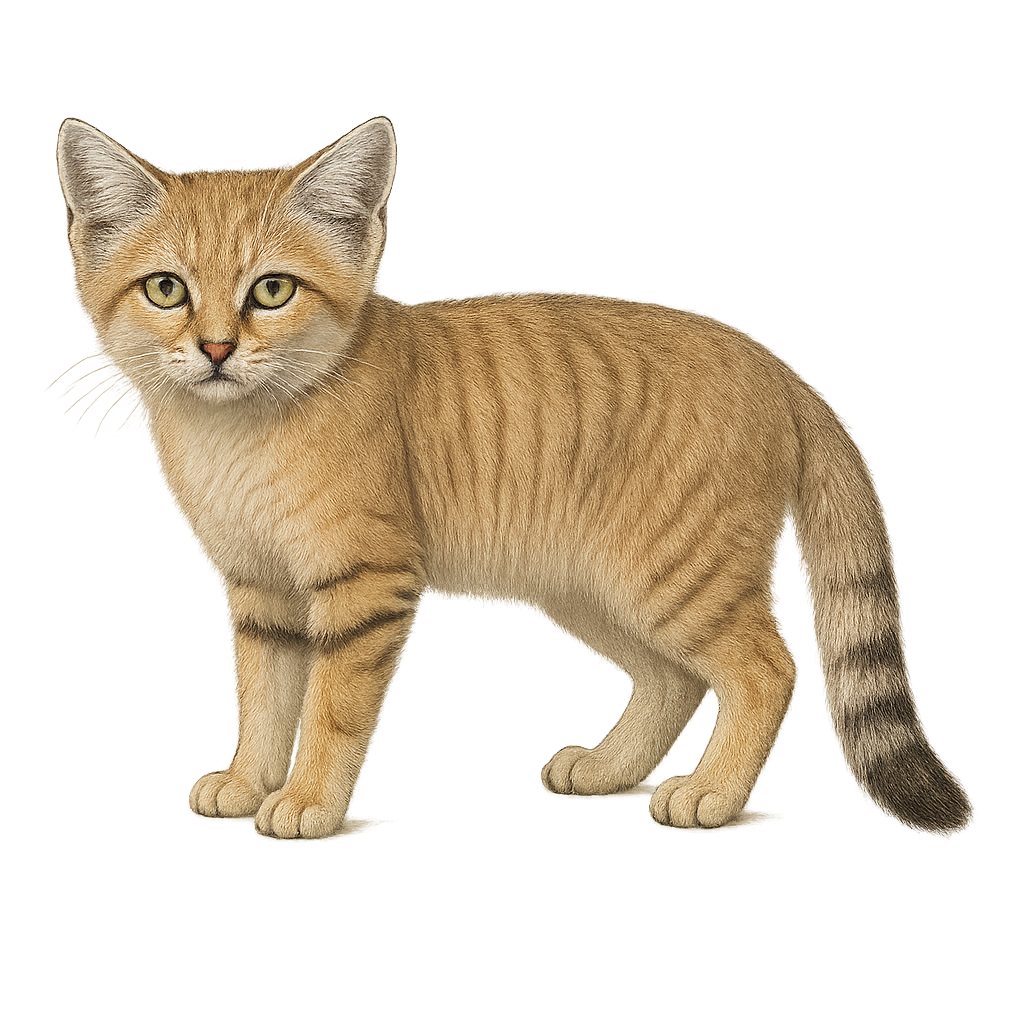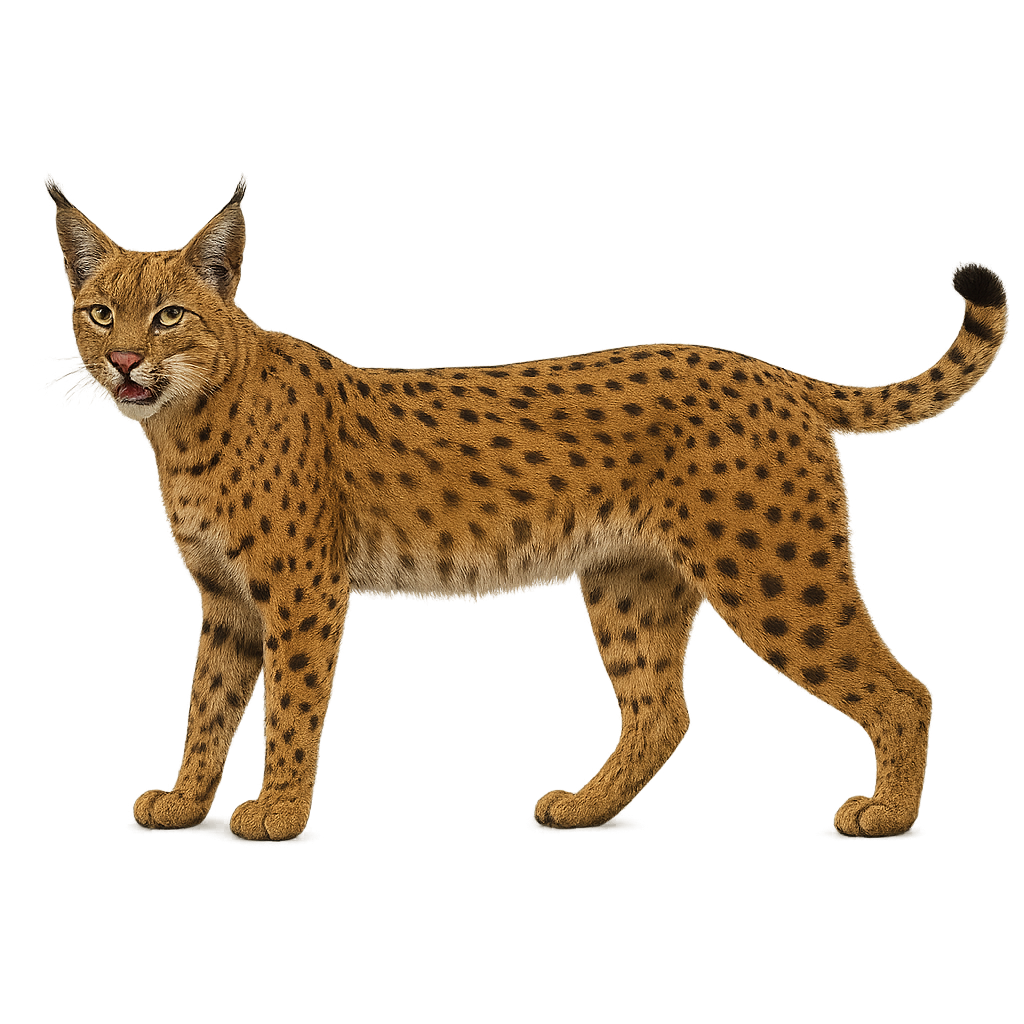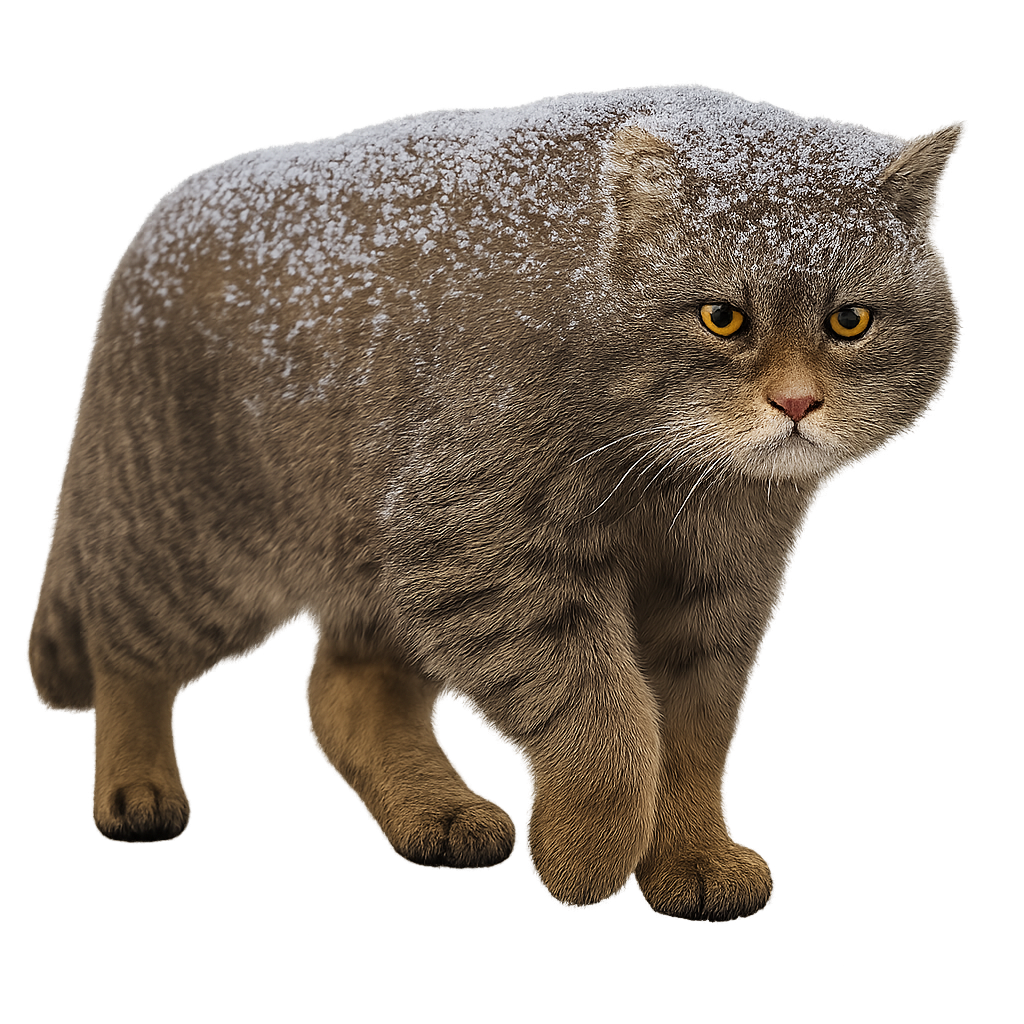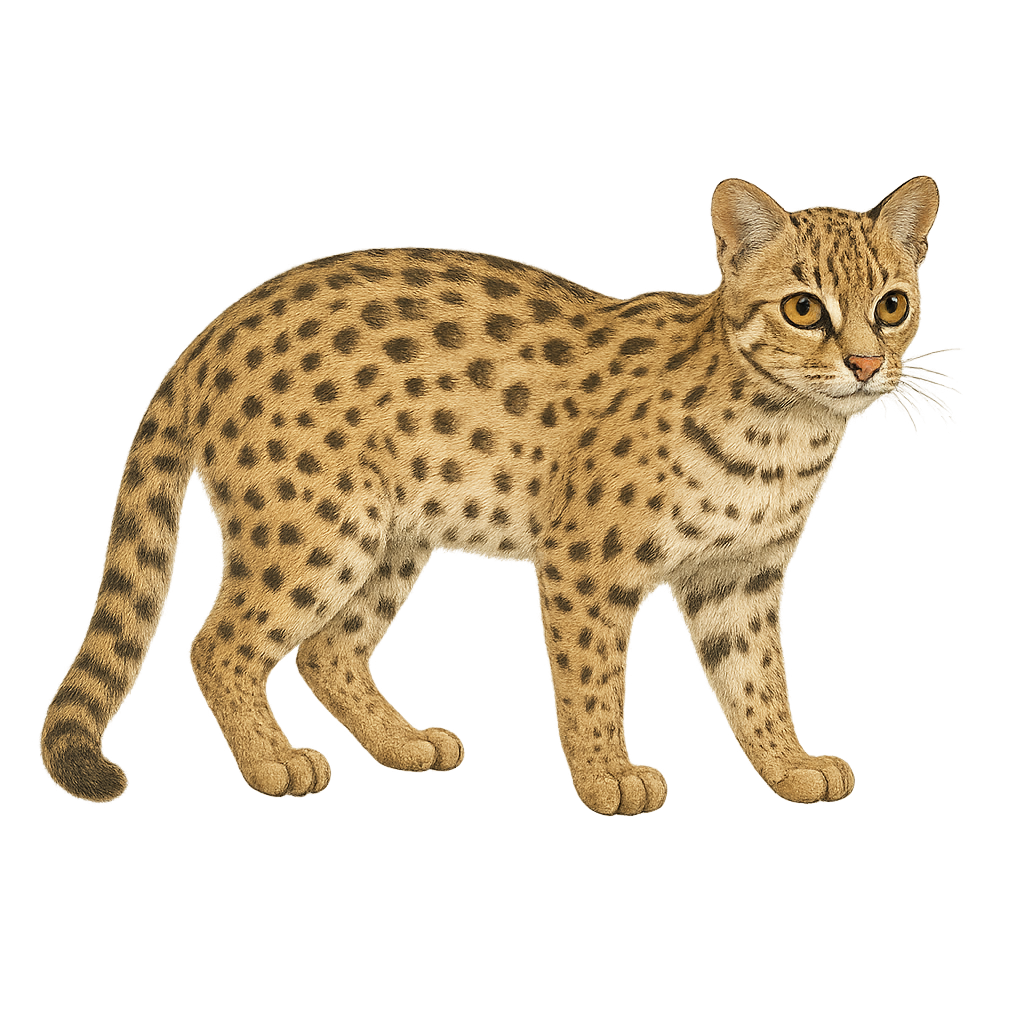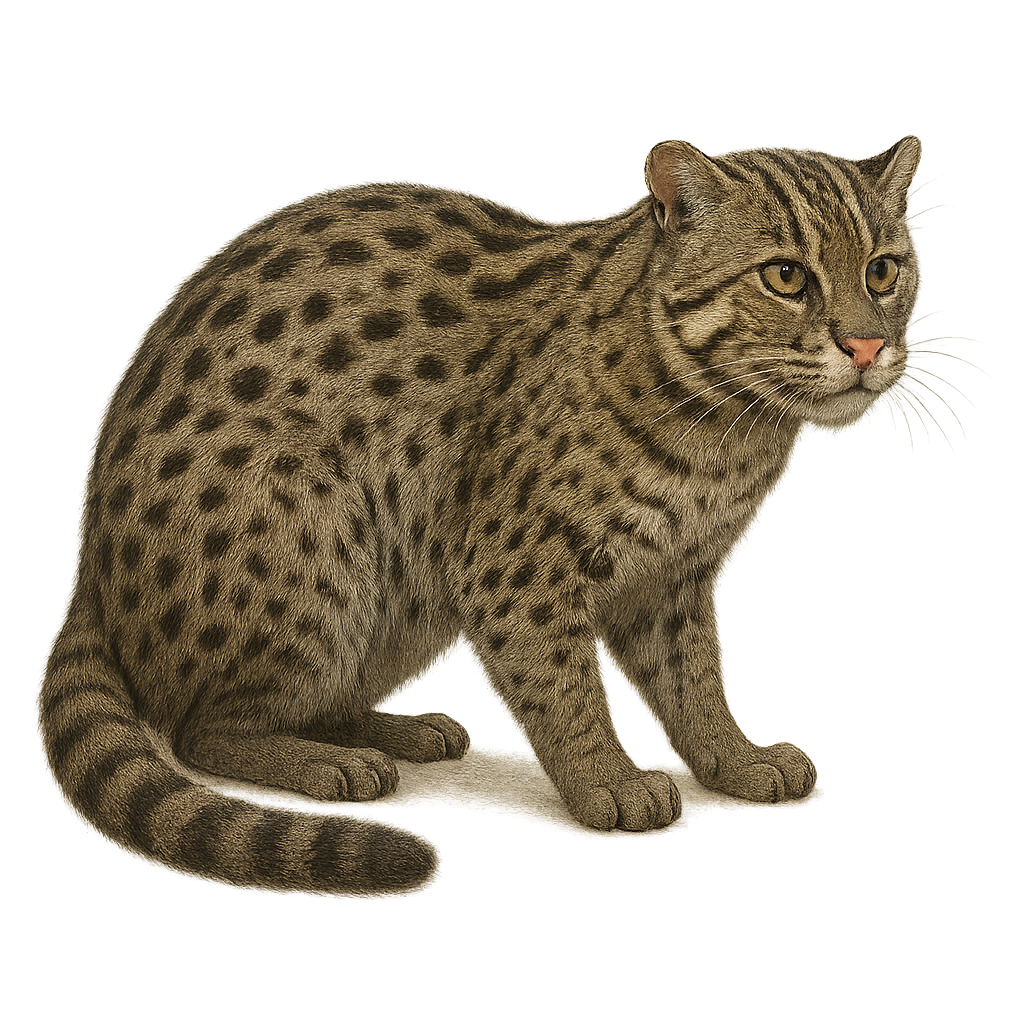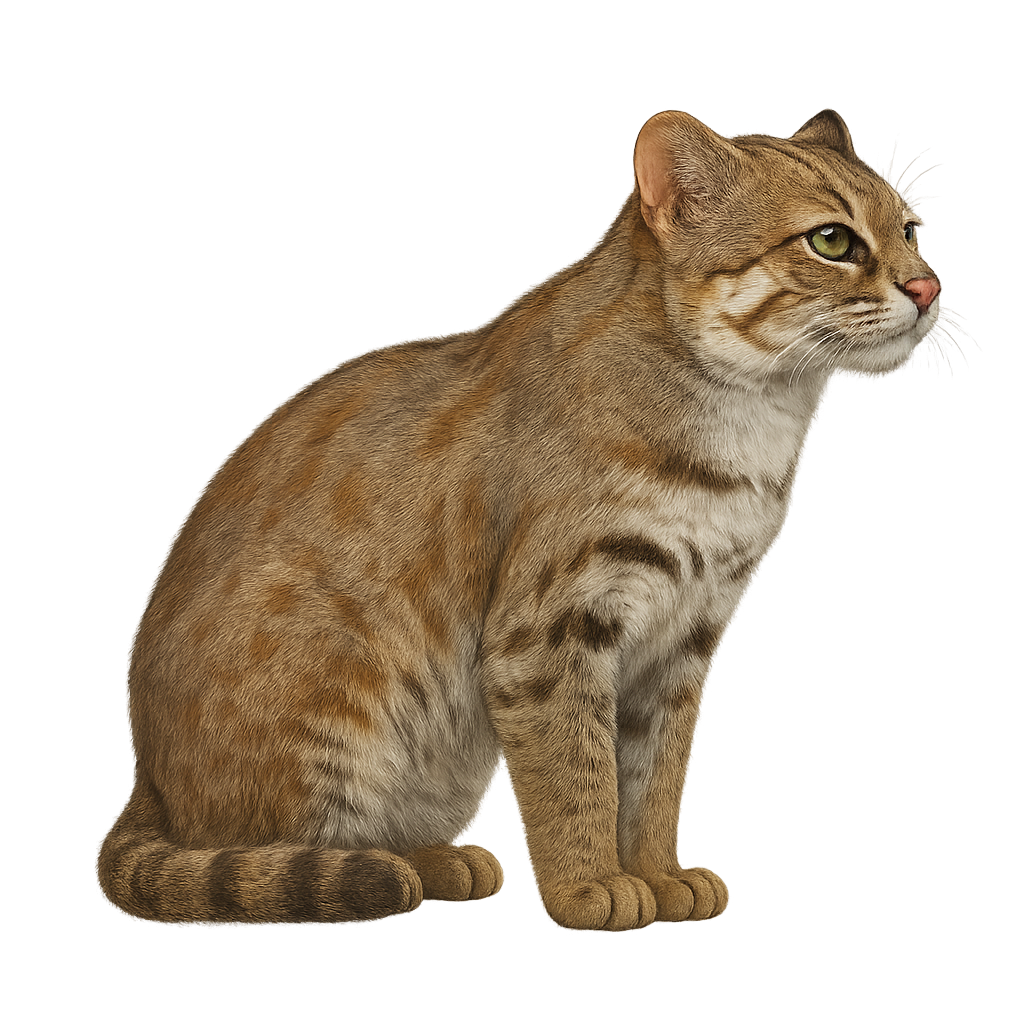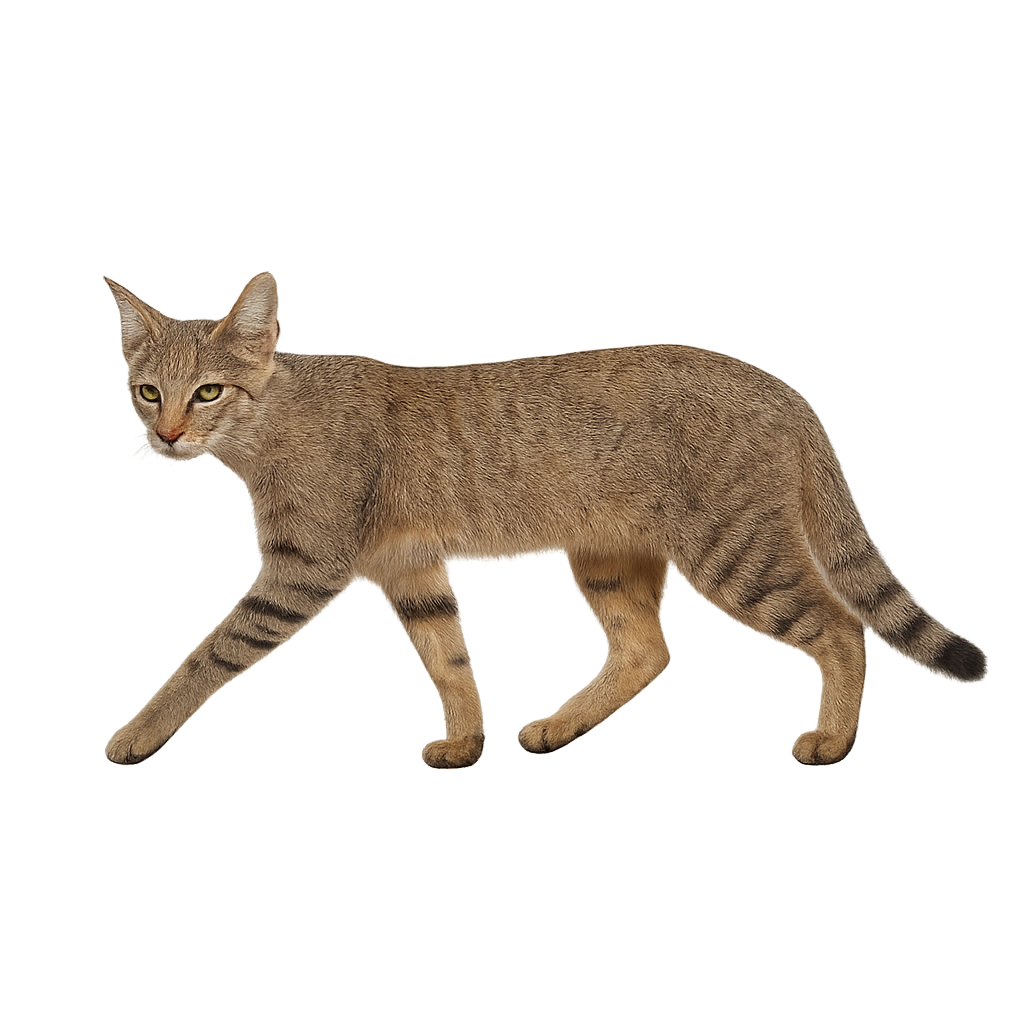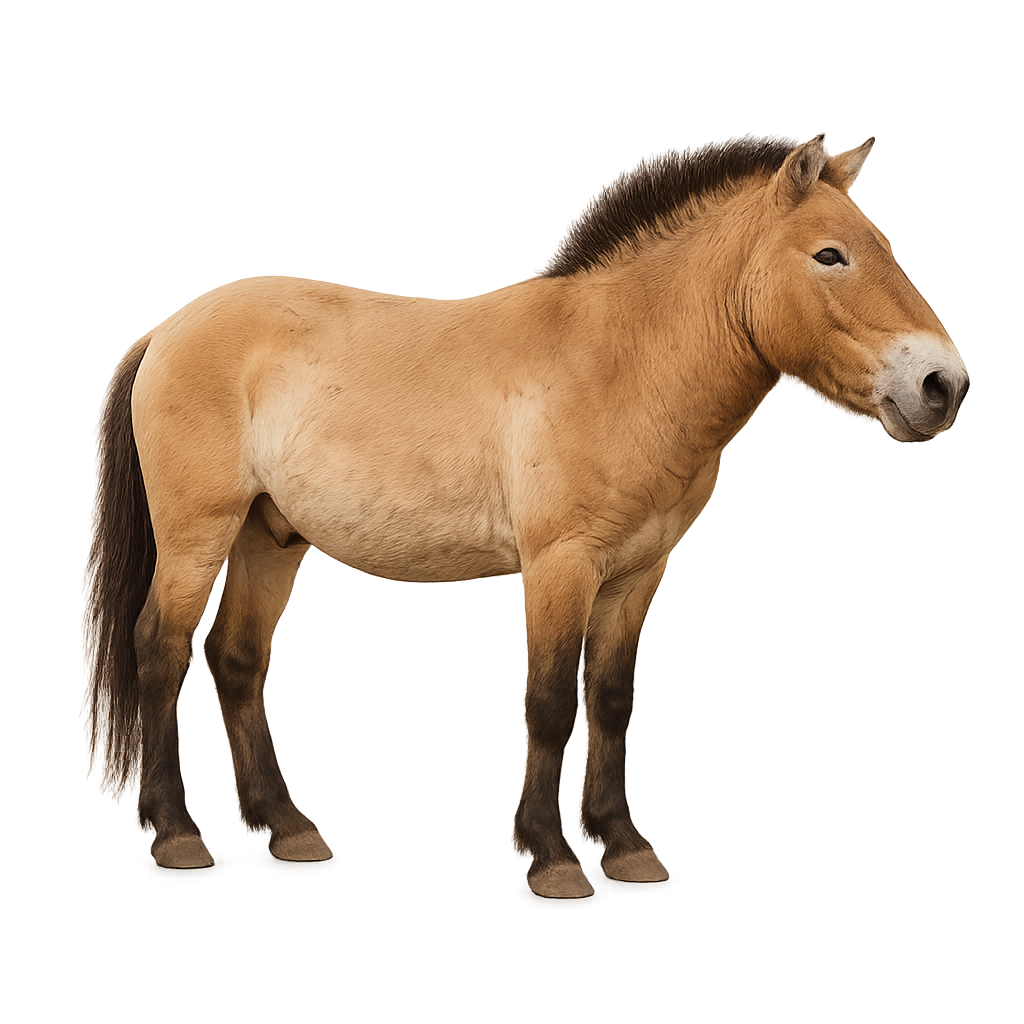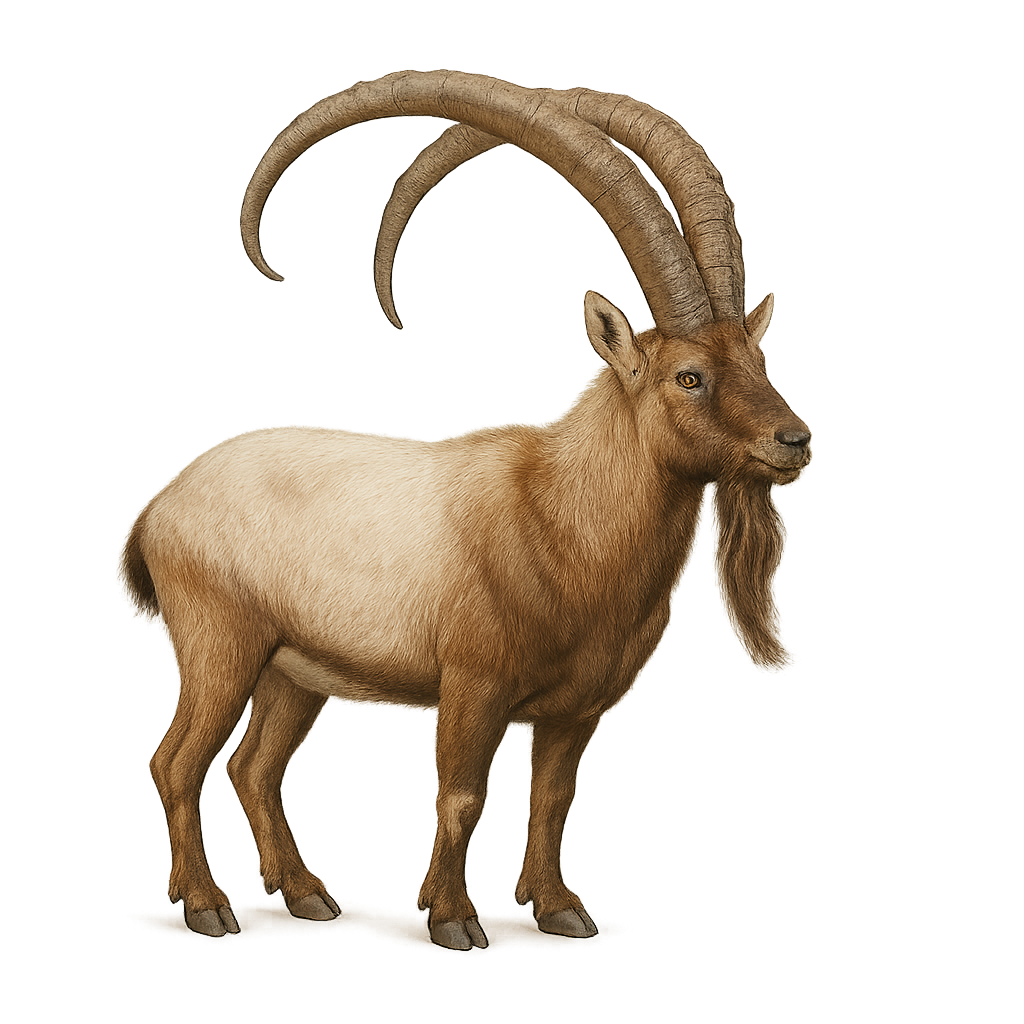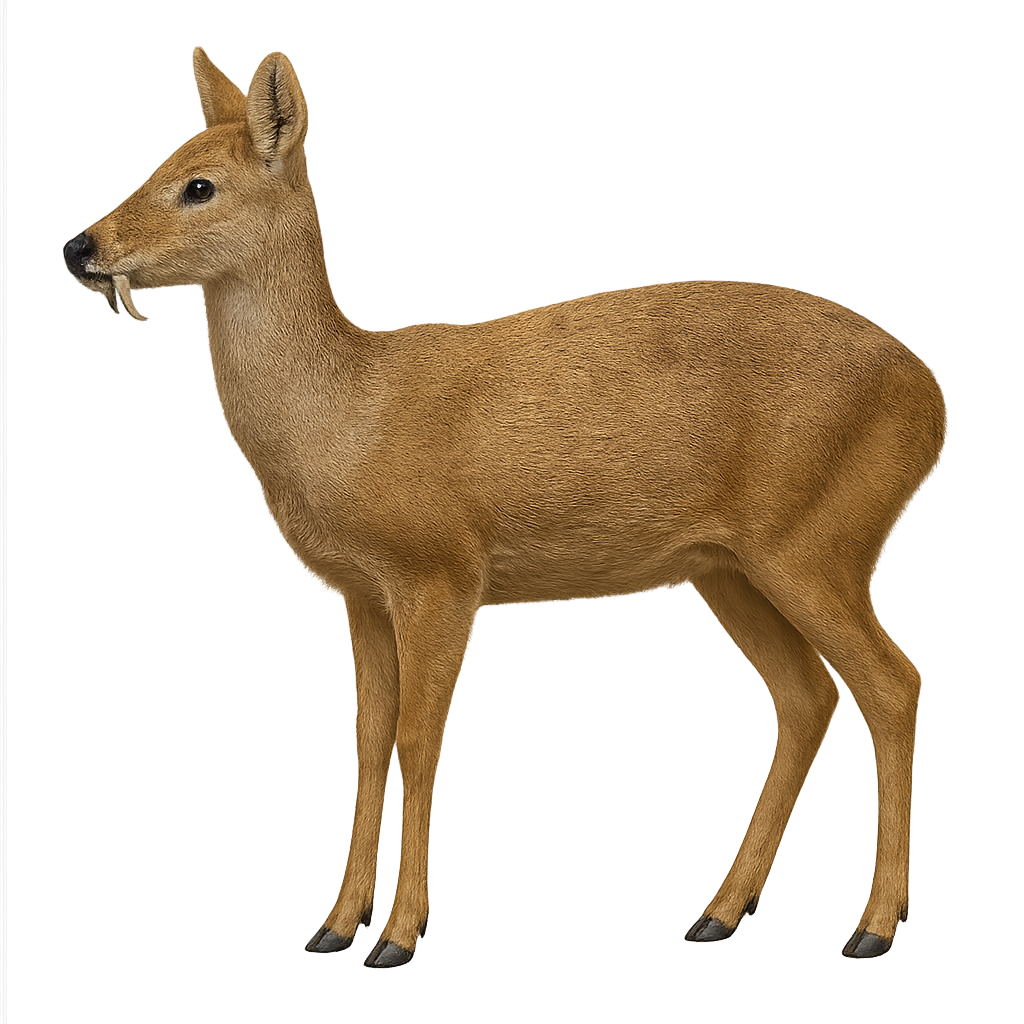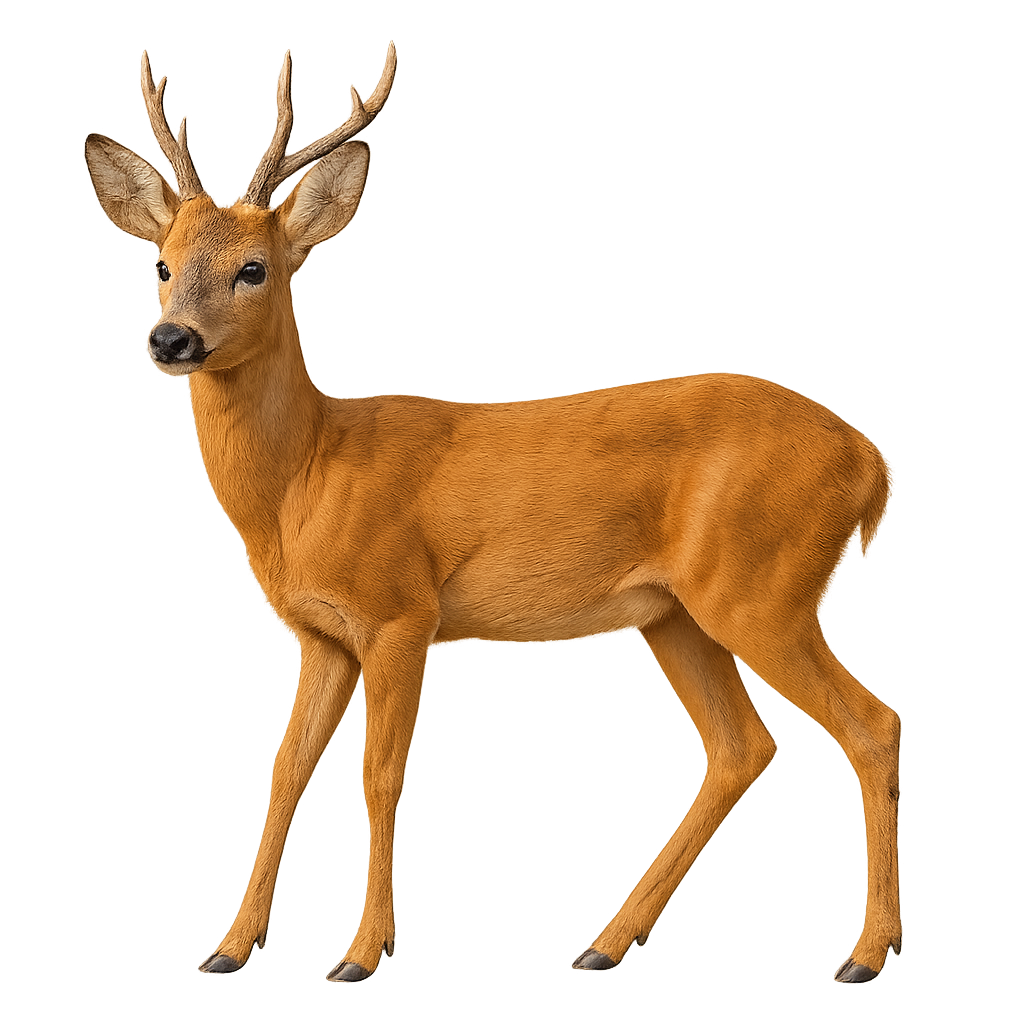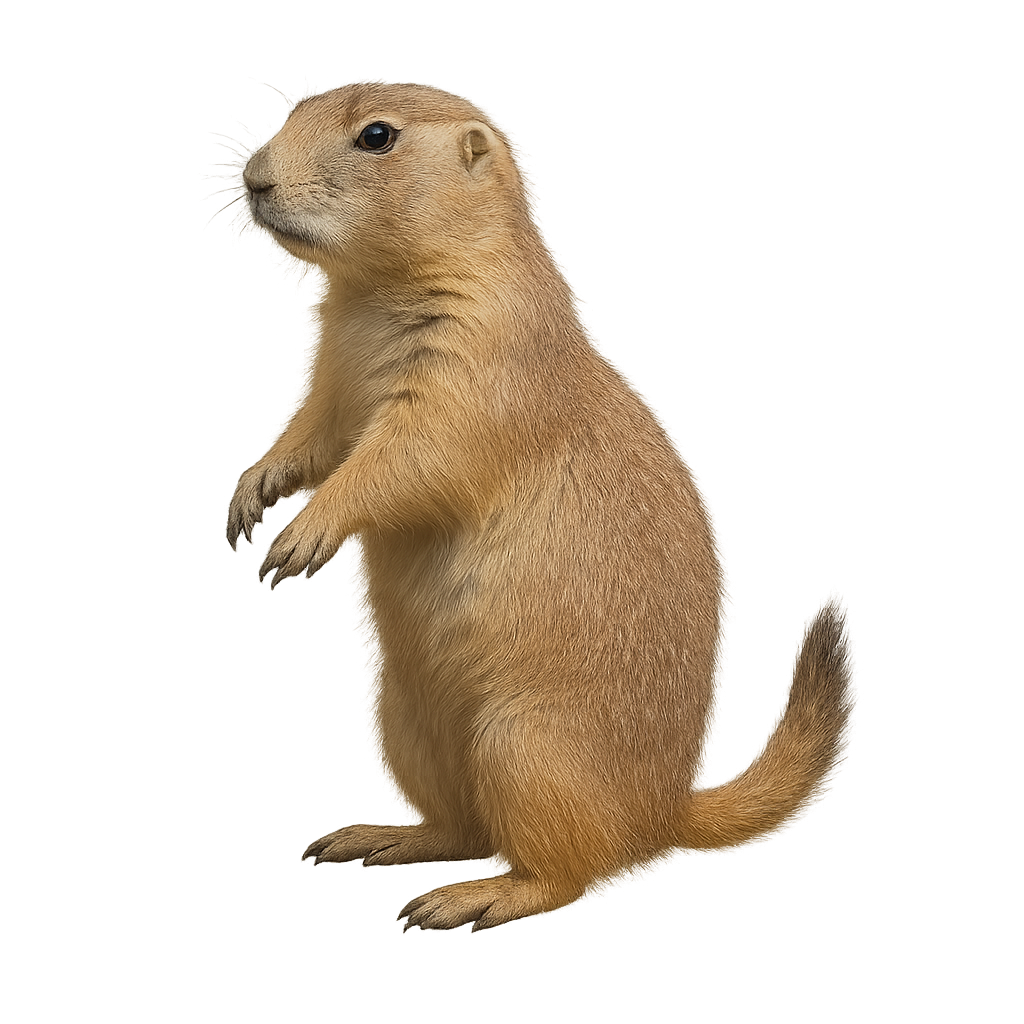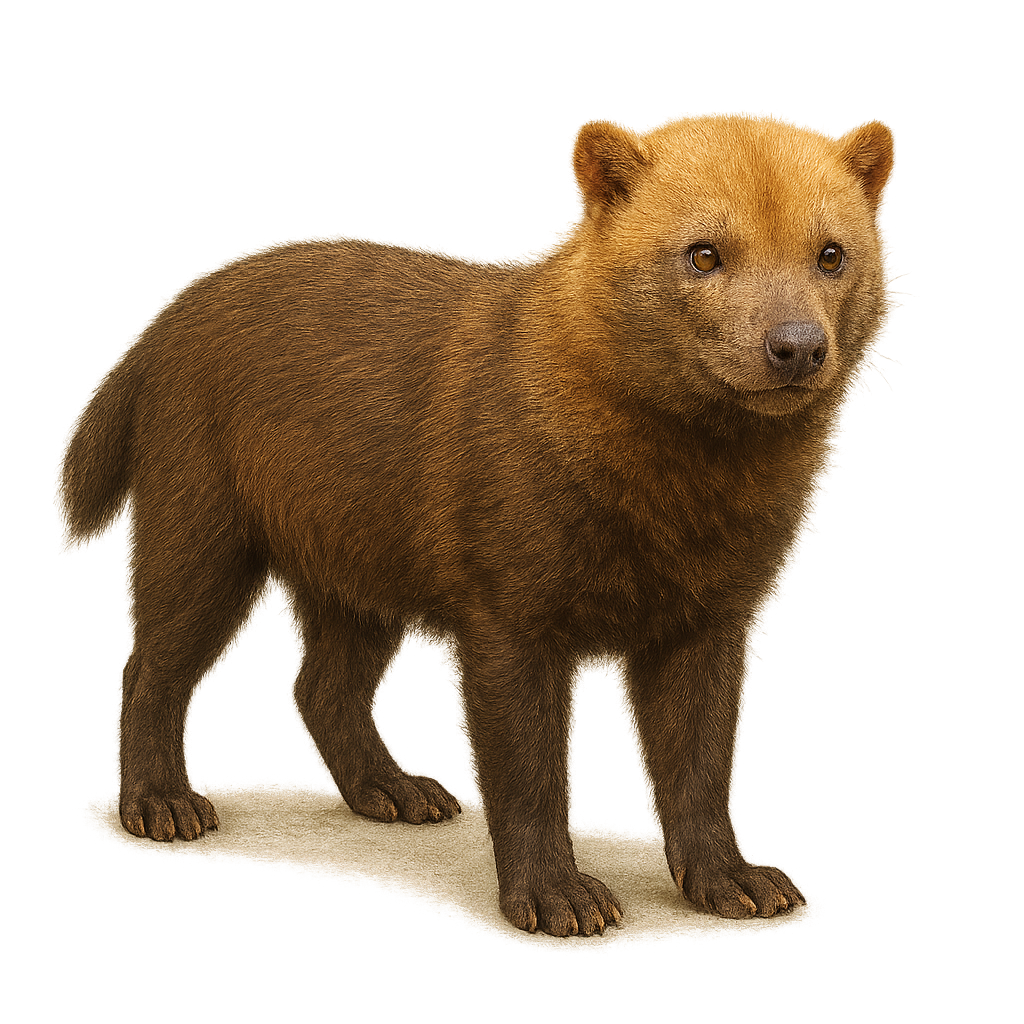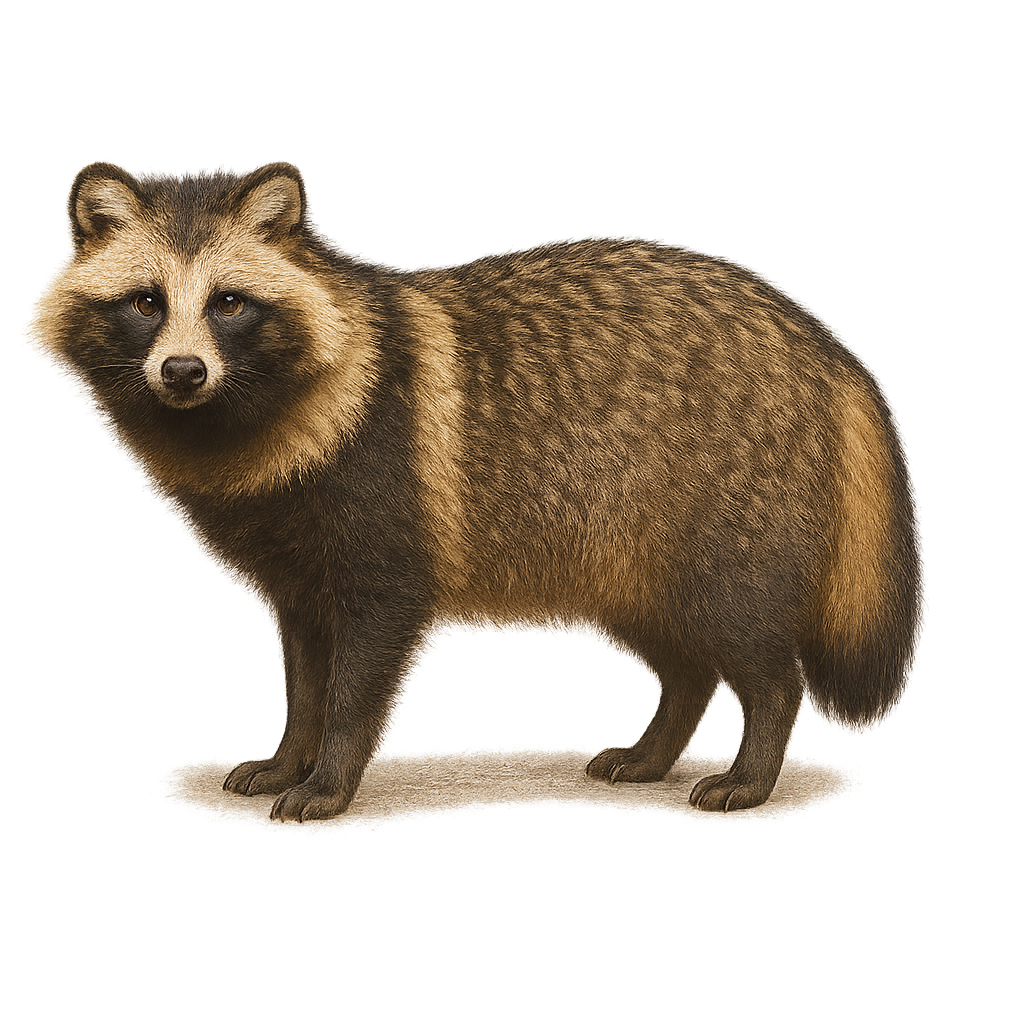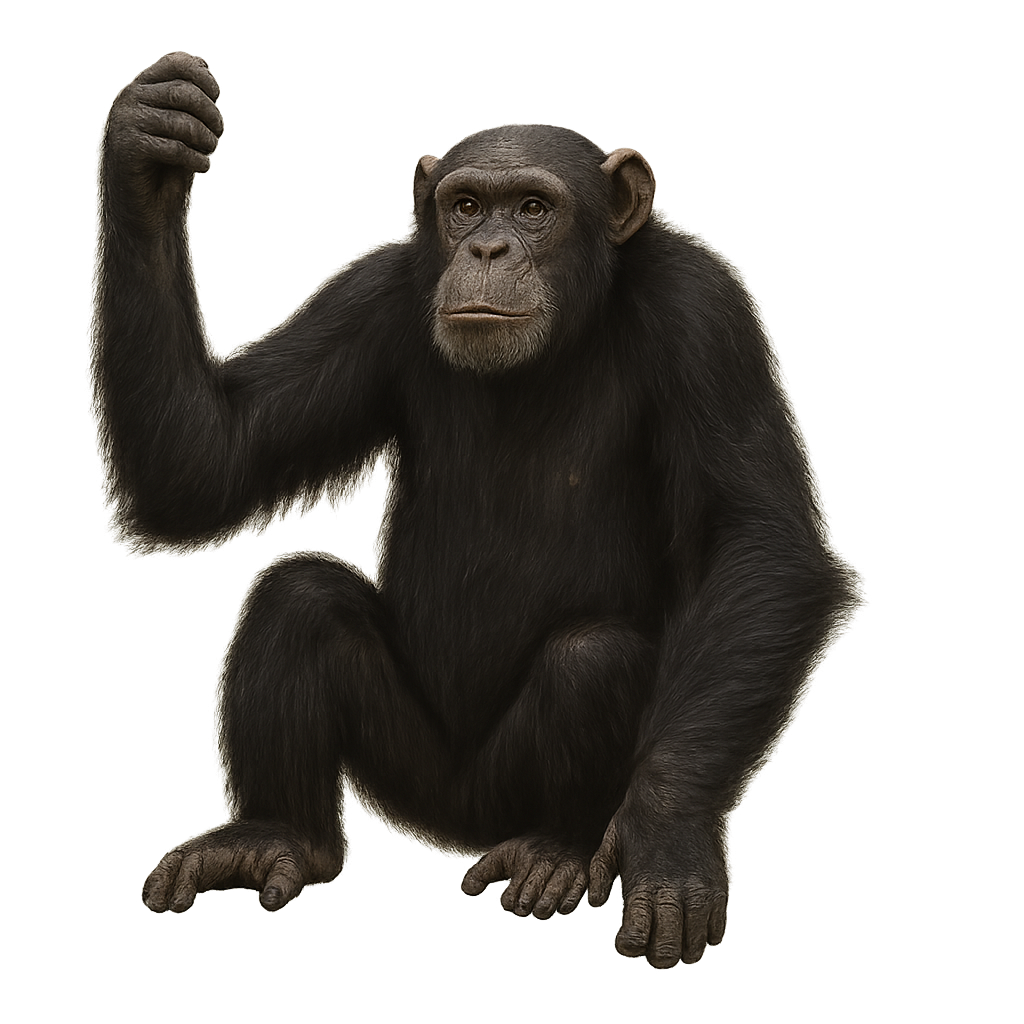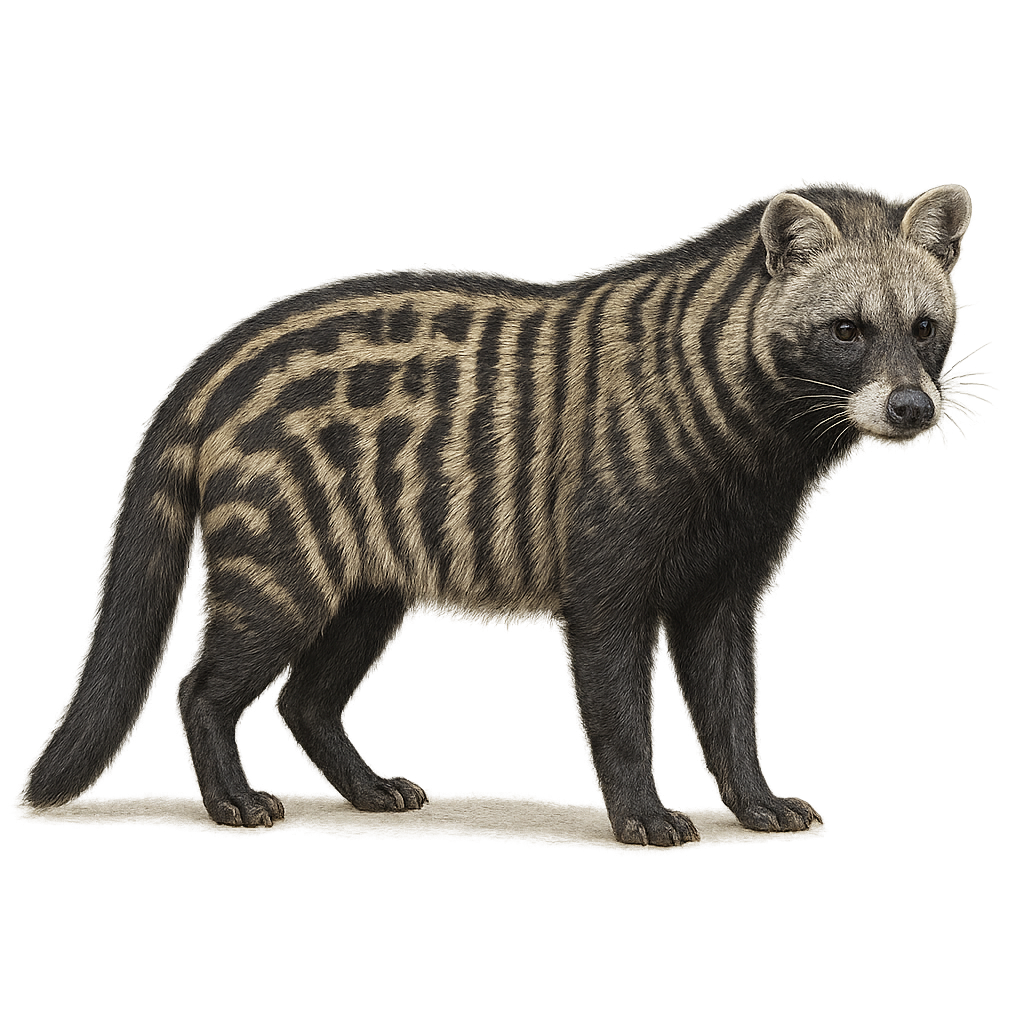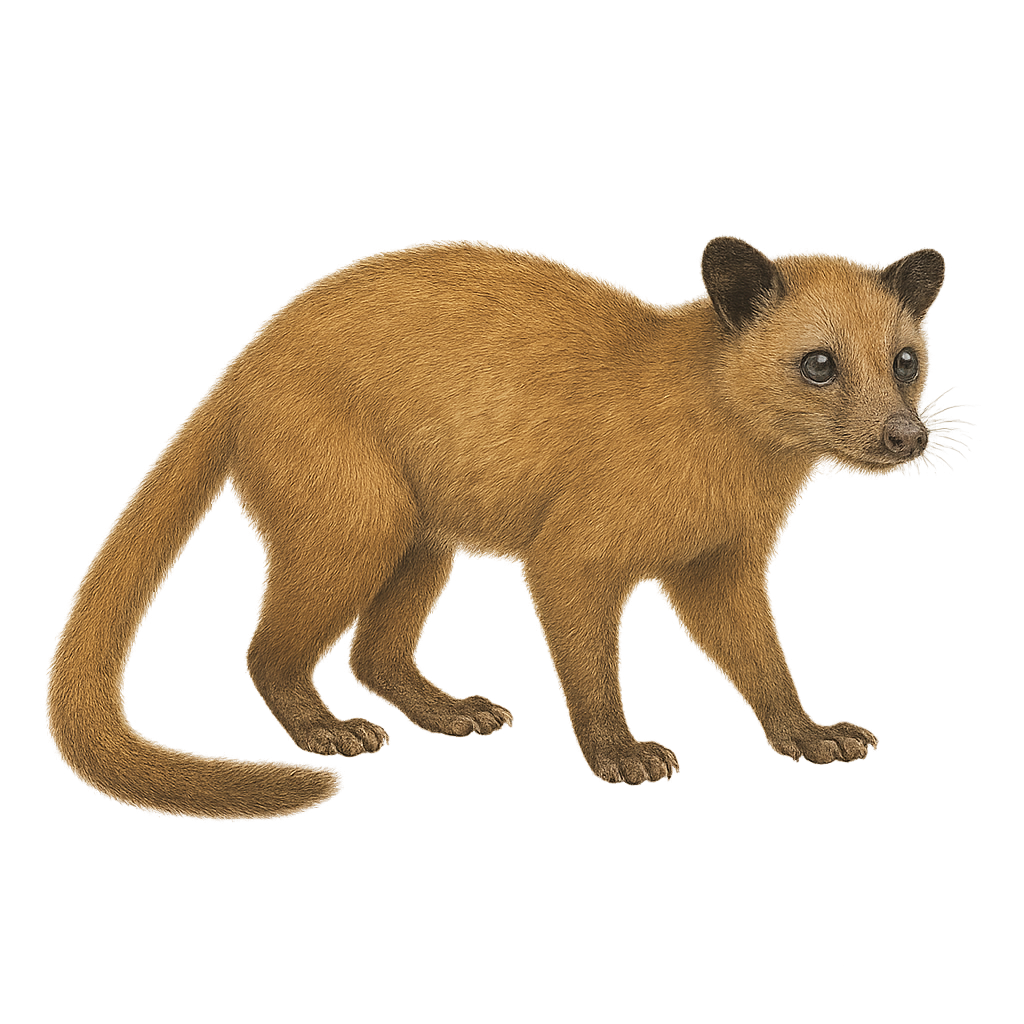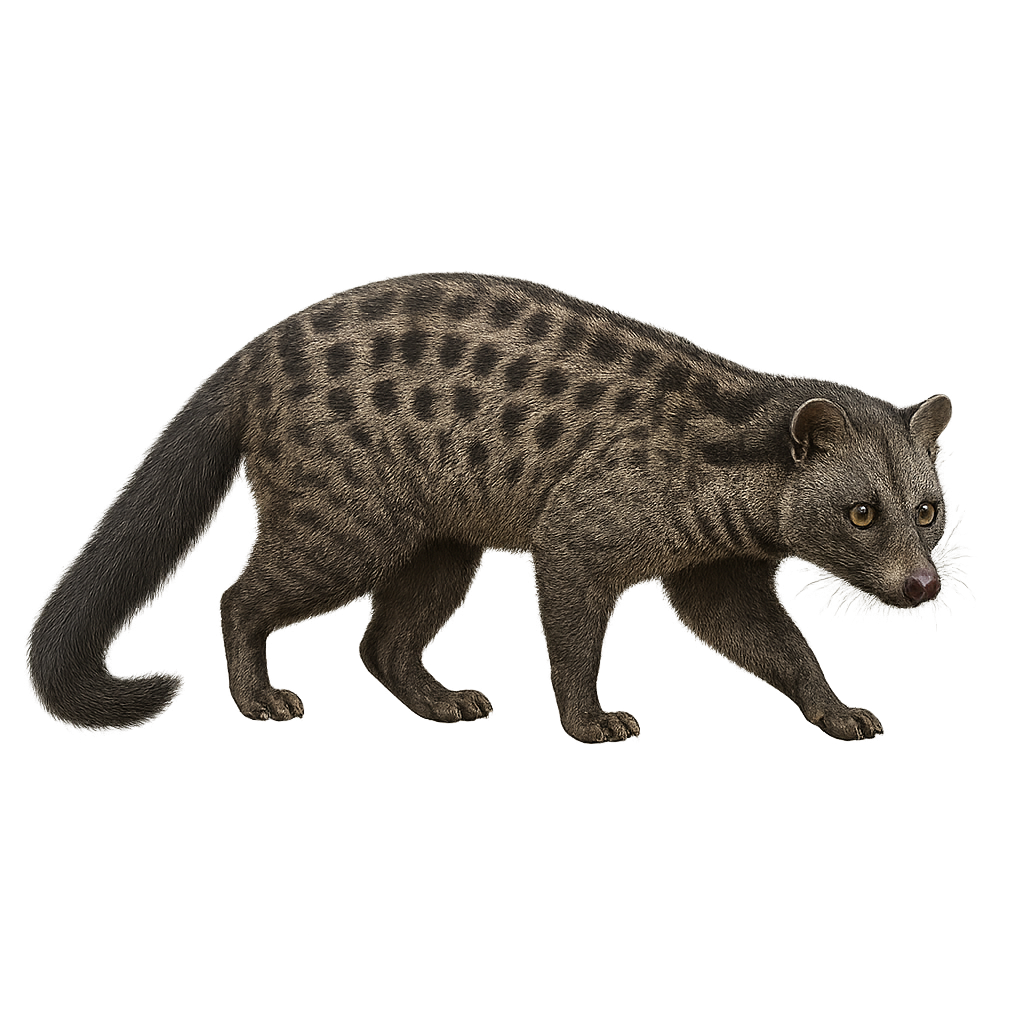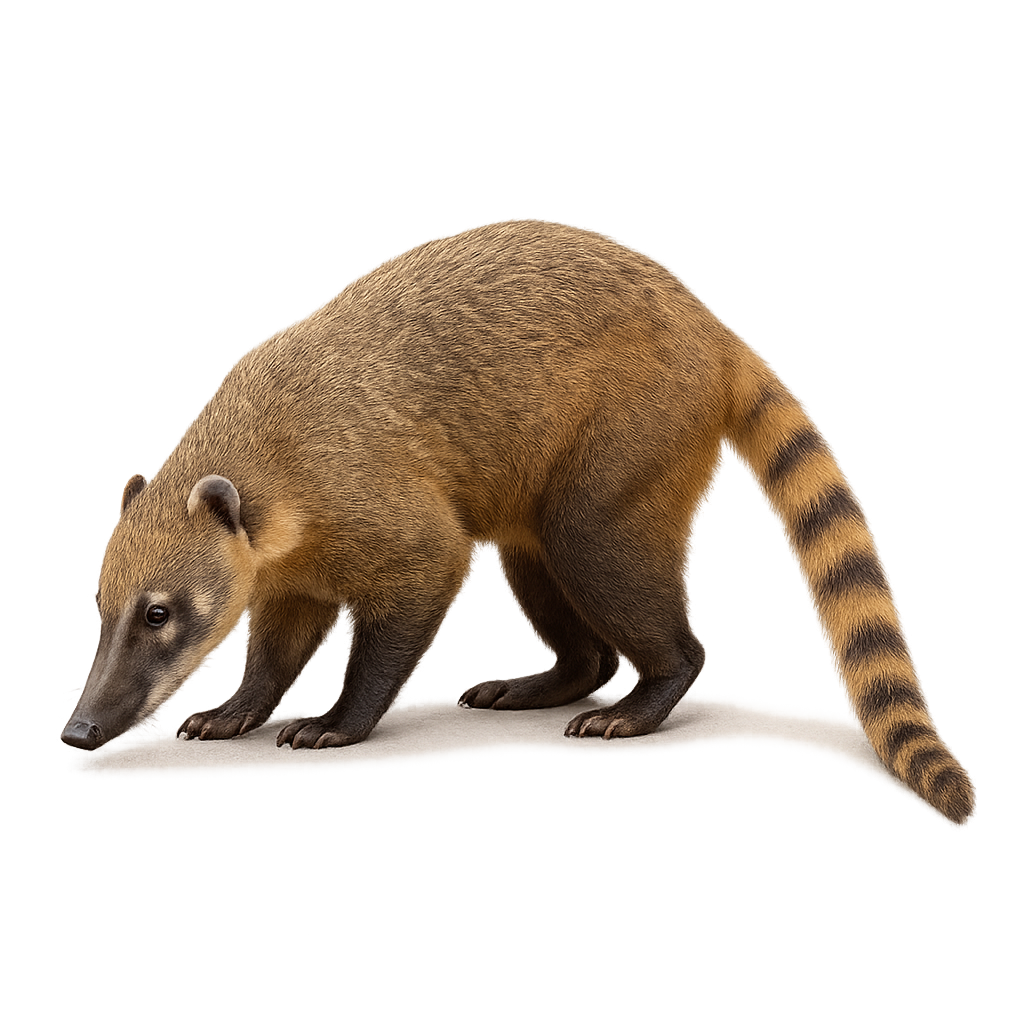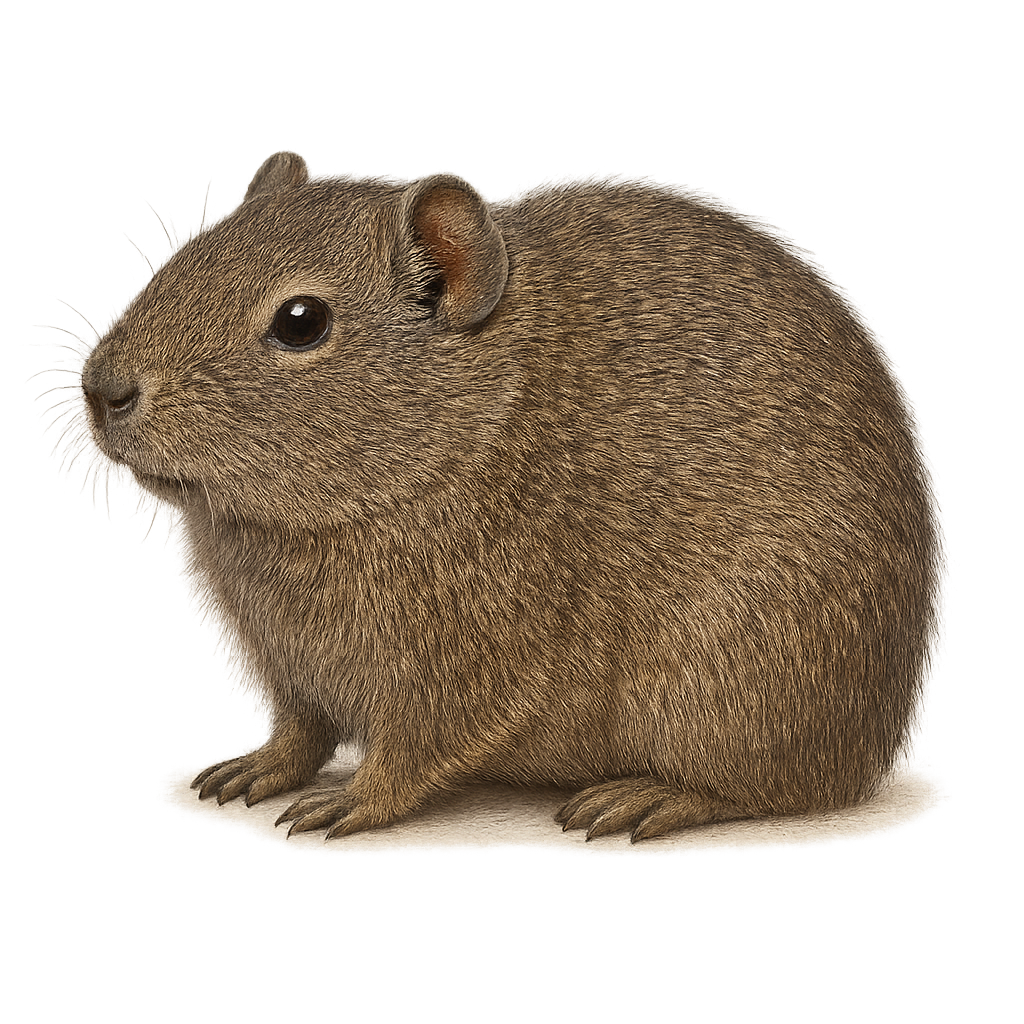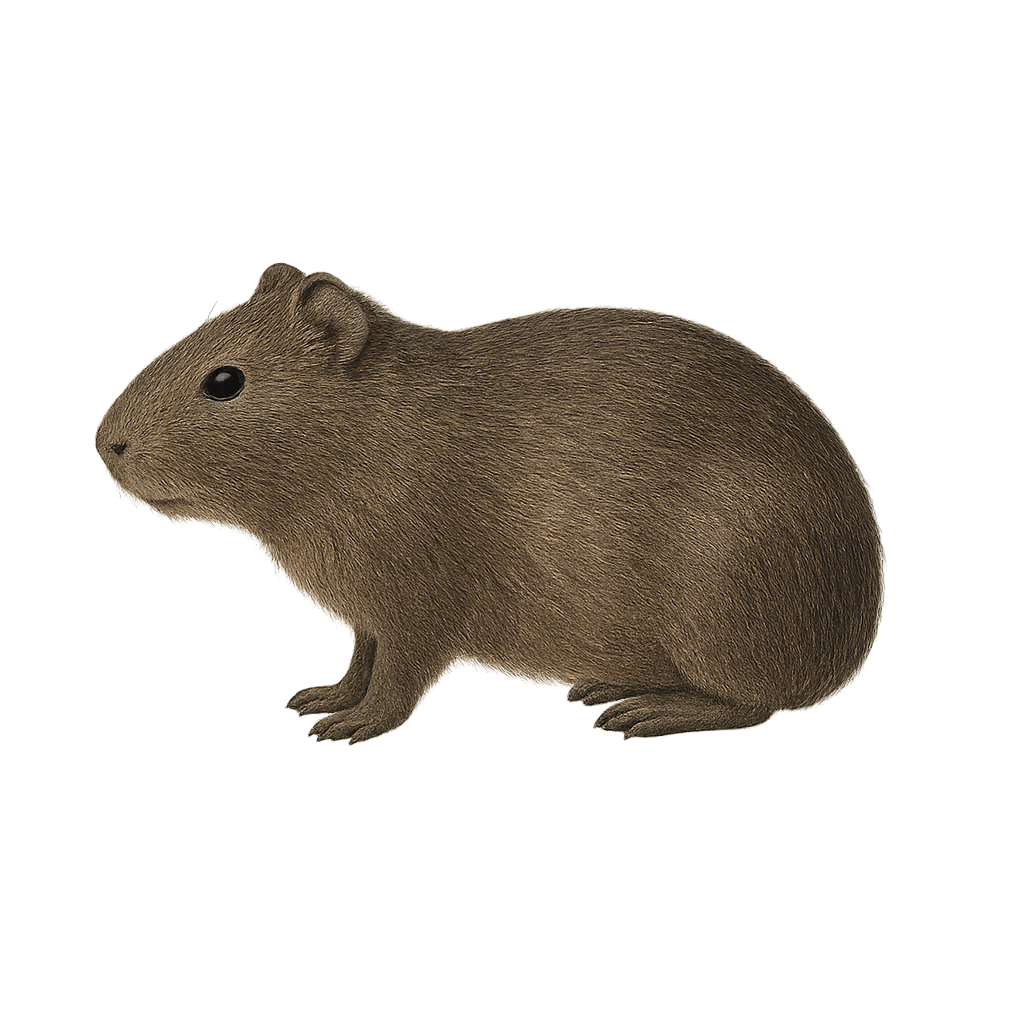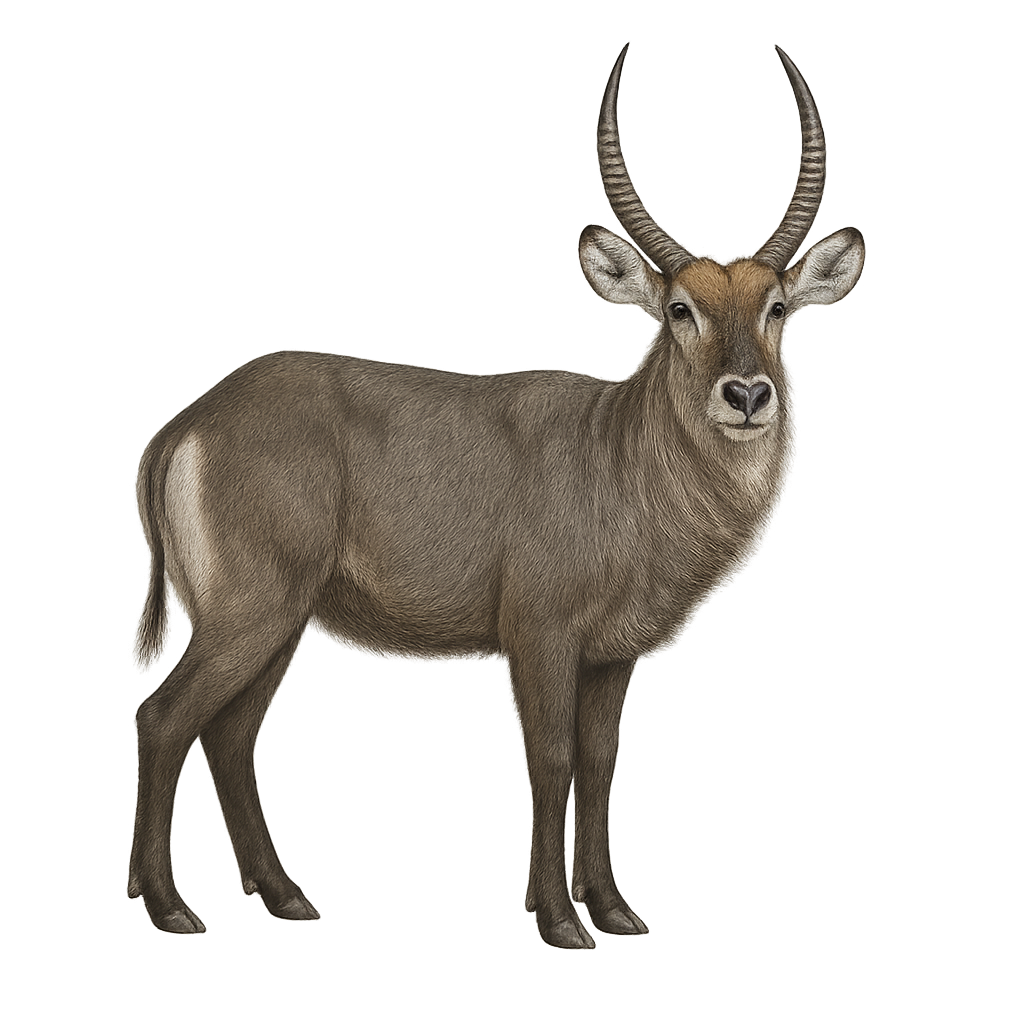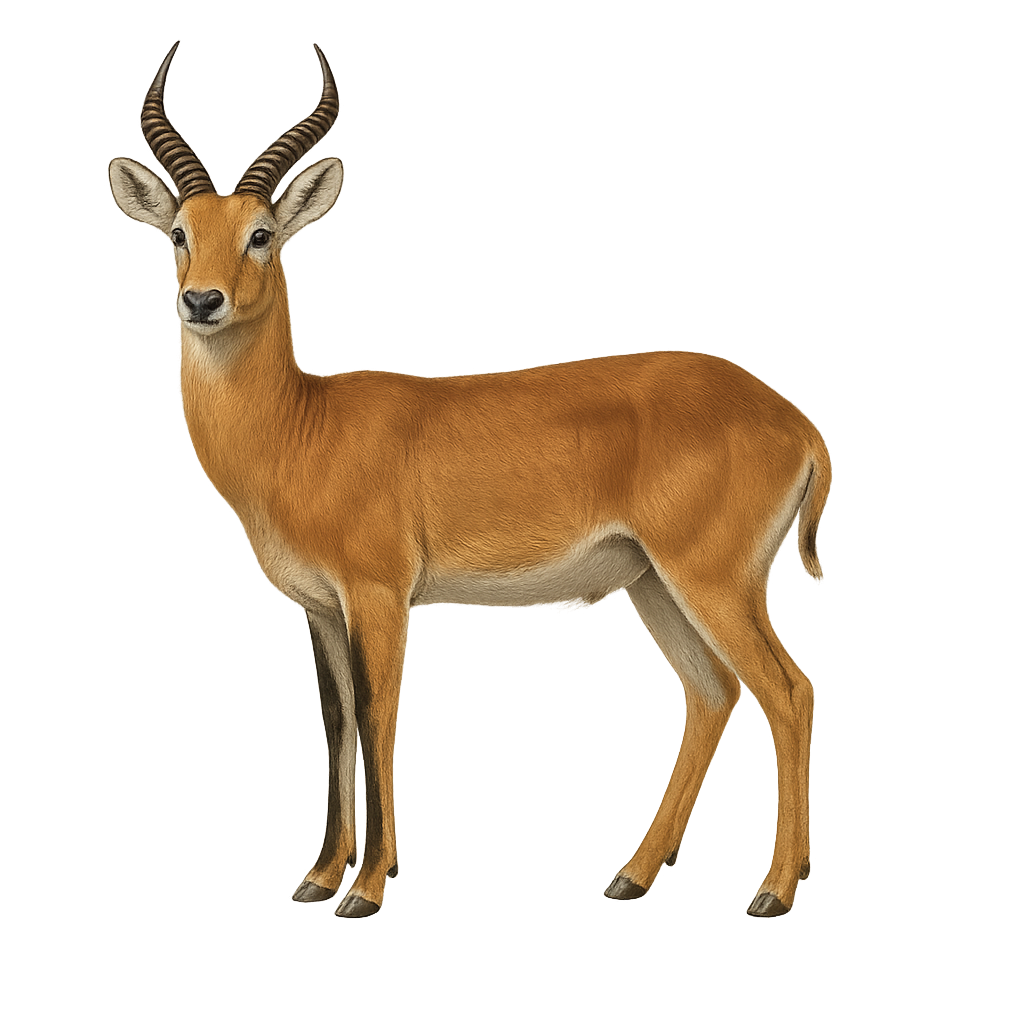The Felis margarita, commonly known as the sand cat, is a fascinating feline that inhabits the desert regions of North Africa and the Middle East. This small cat is perfectly adapted to its arid environment, with wide, furry paws that allow it to walk on hot sand with ease. Its sand-colored coat provides excellent camouflage in its natural habitat. The sand cat is a nocturnal hunter, feeding mainly on small rodents, birds, and insects. It is known for its ability to survive with very little water, obtaining necessary moisture from its prey. Although discreet and difficult to observe, it plays a crucial role in the desert ecosystem by regulating small animal populations.
The African Golden Cat is a rare and mysterious small feline, characterized by its silky golden coat and pointed ears adorned with tufts of black hair. This medium-sized cat primarily inhabits the forests and savannas of West Africa, where it preys mainly on birds, small mammals, and reptiles. Its golden coat, which gives it its name, is perfect for camouflaging in tall grasses and foliage.
The African Golden Cat is a discreet and solitary hunter, primarily active at dawn and dusk. Although it is rare and difficult to observe due to its nocturnal habits, it plays an important role in regulating prey populations. The species is threatened by habitat loss and poaching, although conservation efforts are in place to protect this elusive feline.
The European Wildcat is a small, nocturnal, and discreet feline, often considered the ancestor of the domestic cat. It has a thick coat, typically gray-brown with dark stripes, which allows it to blend into its forested environment. Its size and behavior make it an agile and efficient hunter, primarily active at dusk. The European Wildcat has pointed ears and a slender body, with relatively long legs that allow it to move easily in varied environments, such as deciduous forests and mountainous regions.
This solitary cat feeds mainly on small mammals, birds, and insects, hunting them stealthily. While its population remains stable in some regions, it faces threats, including habitat loss, hybridization with domestic cats, and poaching. Conservation efforts are in place to protect this species, which is considered an important part of the forest ecosystem.
The Scottish Wildcat is a rare and endemic subspecies of the European Wildcat, primarily found in the mountains and forests of Scotland. It is recognizable by its dense, thick coat, which ranges from gray-brown to brown with characteristic dark markings on the head, legs, and tail. Smaller and stockier than the domestic cat, the Scottish Wildcat has slightly rounded ears and a sharp gaze, allowing it to blend perfectly into its wooded and hilly environment.
This cat is a discreet and solitary hunter, primarily active at night, feeding on small mammals, birds, and occasionally insects. It is also an excellent climber and can often be seen in trees or rocky areas. The Scottish Wildcat is considered an endangered species due to habitat loss, hybridization with domestic cats, and poaching. Conservation programs are in place to protect this unique subspecies and preserve its habitats.
The Prionailurus bengalensis, or leopard cat, is a small wild feline widely distributed in Asia. It has a spotted coat reminiscent of a leopard, hence its name. This feline is particularly agile and adapts to various environments, from tropical forests to agricultural areas. It is primarily nocturnal and solitary, although it may sometimes be seen in pairs during the breeding season. Its size ranges from 38 to 66 cm, with a tail of 17 to 31 cm. The leopard cat is an opportunistic predator, feeding on small mammals, birds, and insects. Although still relatively common, deforestation and hunting pose increasing threats to its survival.
The fishing cat, or Prionailurus viverrinus, is a medium-sized feline primarily found in South and Southeast Asia. It is well adapted to aquatic life, with partially webbed feet that allow it to swim efficiently. Its coat is grayish with dark spots, providing excellent camouflage in marshy habitats. The fishing cat is an opportunistic predator, feeding mainly on fish, but also on small mammals, birds, and insects. Unfortunately, it is threatened by habitat loss due to human expansion and wetland pollution. Its population is declining, making it a vulnerable species according to the IUCN.
The rusty-spotted cat, Prionailurus rubiginosus, is one of the smallest wild cats in the world, measuring about 35 to 48 cm in length, with a tail of 15 to 30 cm. Its coat is gray-brown with distinctive rusty spots, hence its name. This feline primarily inhabits dry forests and grasslands in India and Sri Lanka. It is nocturnal and solitary, feeding on small mammals, birds, and insects. Although discreet, it is an agile and fast hunter. Its ability to climb trees and sneak through dense bushes allows it to escape predators. Deforestation and habitat loss are the main threats to its survival.
The African Wildcat is a small, discreet, and nocturnal feline, primarily found in desert regions, savannas, and open forests of North and Sub-Saharan Africa. It is often compared to the domestic cat but has a more uniform coat, typically sandy or gray-brown, with light markings on the head and paws. Its eyes are large, adapted for nocturnal vision, and its ears are pointed, enhancing its wild appearance.
This cat is a solitary hunter, feeding mainly on small mammals, birds, and insects. Although shyer than its domestic cousin, it plays an essential role in regulating prey populations in its habitat. It is also known as the ancestor of the domestic cat, which was domesticated from this species around 10,000 years ago. While the African Wildcat is still relatively widespread, it is threatened by habitat loss and human conflict.
Przewalski's horse is a rare and hardy species of wild horse native to the steppes of Central Asia. It is the last true wild horse species still in existence, descended from ancestors that survived the Ice Age. This horse is characterized by its small size, tawny coat, and erect mane. Although it disappeared from the wild, it has been successfully reintroduced to its native habitats. Threatened by habitat loss and hunting, it is currently considered a vulnerable species.
The Mountain Goat is a robust mammal well adapted to life in the rugged mountains and rocky terrain of North America. This herbivore is easily recognizable by its white or cream-colored coat, which helps it blend into the snow and rocks. Its legs are specially adapted for climbing, with wide and rigid hooves that provide excellent traction on steep slopes.
The Mountain Goat feeds primarily on herbaceous plants, lichens, and moss, which it finds in rocky slopes and alpine meadows. While it is often perceived as a hardy species, it faces threats from habitat loss, poaching, and diseases transmitted by domestic animals. The population of Mountain Goats is closely monitored, and efforts are underway to protect this iconic species of the mountains.
The wild goat, or Capra aegagrus, is a robust and agile animal native to the mountains of Western Asia. It is the ancestor of the domestic goat and is distinguished by its impressive, curved horns, especially prominent in males. Its coat ranges from brown to gray, providing excellent camouflage in its rocky habitat. Wild goats live in groups, often consisting of females and young, while adult males are more solitary. They are well adapted to rugged terrains and can climb with remarkable agility. Their diet mainly consists of mountain vegetation, making them dependent on climatic conditions and the availability of natural resources.
The water deer is a small semi-aquatic deer, 45–55 cm at the shoulder, with tawny fur and an elongated muzzle. Native to China and Korea and introduced in parts of Europe, it inhabits marshes, rivers, and wetlands, feeding on aquatic plants, grasses, and riparian thickets. Solitary and crepuscular, it often moves under vegetative cover.
The Siberian Roe Deer, also known as the Asian Roe Deer, is a slightly larger species of cervid compared to the European Roe Deer. It is easily recognizable by its darker coat, ranging from brown to gray, with white markings around the mouth and belly. Males carry antlers that, while smaller than those of other large cervids, are still distinct and visible. This species primarily inhabits coniferous forests and wooded areas of Siberia, Central Asia, and Mongolia, where it hides during the day and becomes more active at dusk and night.
The Siberian Roe Deer is an herbivore, primarily feeding on vegetation, including young shoots, leaves, fruits, and bark. It is known for its great agility and speed, allowing it to move easily through the rugged terrain of its habitat. While its population remains stable in some regions, it is threatened by deforestation, hunting, and habitat fragmentation.
The Roe Deer is an elegant, small cervid, recognizable by its slender figure and long legs. It has a coat that changes with the seasons: reddish-brown in summer, becoming more gray-brown in winter. Males carry antlers, which grow back each year and are generally smaller than those of other cervids. The Roe Deer primarily lives in forests, wooded areas, and heathlands, where it hides during the day and becomes more active at dusk and night, particularly for feeding.
Its diet is varied, consisting of leaves, fruits, young shoots, and bark. While it is generally discreet and solitary, it can sometimes be seen in small groups, especially in winter. The Roe Deer is an agile and fast animal, capable of covering large distances in a short time when threatened. While its population remains relatively stable, it faces threats from hunting and habitat loss.
The black-tailed prairie dog is a small social ground squirrel about 30 cm long with sandy-brown fur and a black-tipped tail, living in dense burrow colonies on North American grasslands. It feeds on grasses, roots and seeds. During the breeding season, males actively defend territories with alarm calls and erect postures.
The bush dog, or Speothos venaticus, is a medium-sized canid native to South America. It is characterized by its dark brown fur, short legs, and stocky body. Adapted to forest life, it is often found near water, where it hunts in packs. This social predator is known for its ability to take down prey larger than itself, thanks to exceptional coordination within its group. Although elusive, it plays a crucial role in the ecosystem by regulating prey populations. Unfortunately, deforestation and hunting have reduced its numbers, making it vulnerable to extinction.
The raccoon dog, or Nyctereutes procyonoides, is a canid native to East Asia, known for its thick fur and distinctive facial mask resembling that of a raccoon. This omnivorous mammal adapts to various environments, from forests to wetlands. Primarily nocturnal and crepuscular, it feeds on small animals, fruits, and vegetation. Although often solitary, it can form monogamous pairs. Introduced to Europe for fur farming, it has established itself in some regions. Its adaptability and varied diet make it a resilient species, though its impact on local ecosystems is sometimes debated.
The Japanese Raccoon Dog, or Nyctereutes viverrinus, is a medium-sized canid known for its thick fur and resemblance to a raccoon. Native to Japan, it thrives in temperate climates and is primarily found in forests, grasslands, and wetlands. This omnivorous mammal feeds on fruits, insects, small animals, and occasionally human waste. It is notable for its ability to climb trees, a rare trait among canids. The Japanese Raccoon Dog is a social animal, often seen in small family groups. Although hunted for its fur, it is not considered endangered.
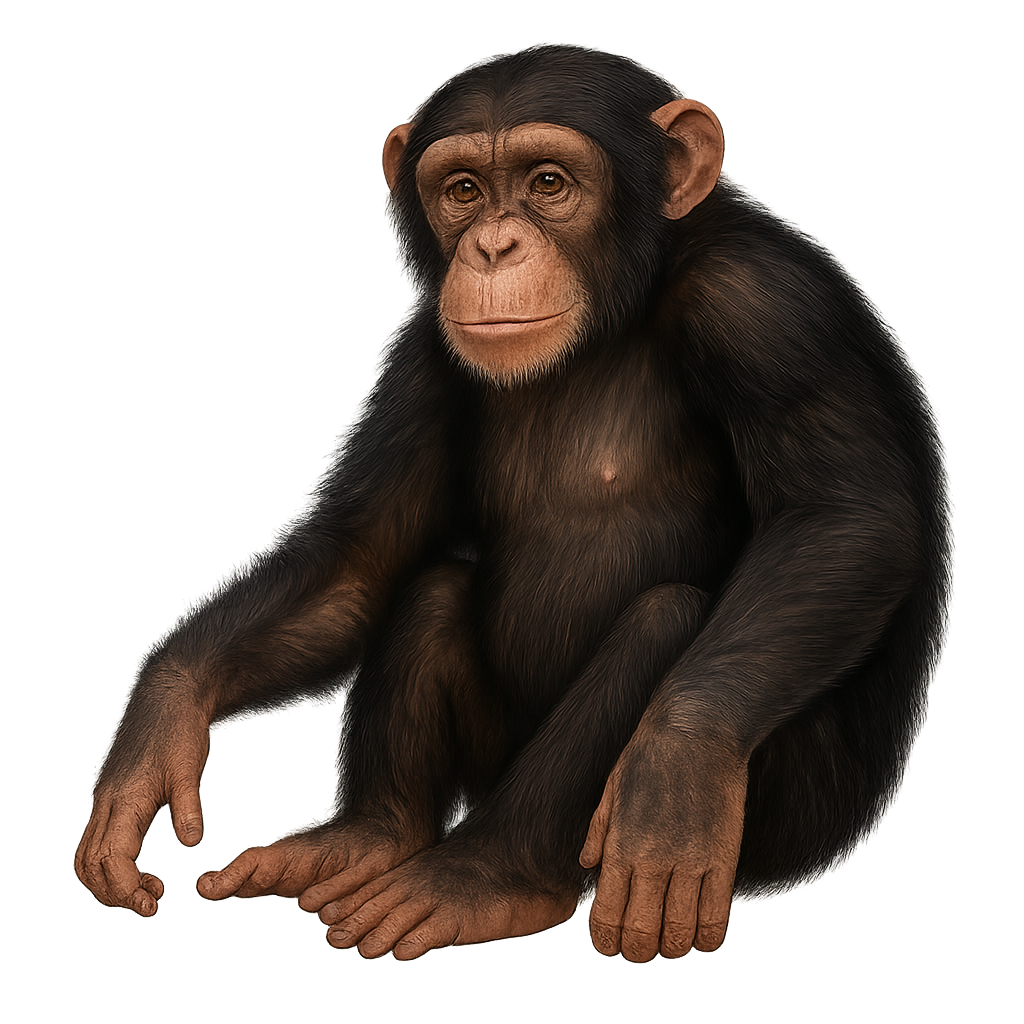
The Chimpanzee is one of humans' closest relatives, sharing about 98% of its DNA with humans. This large primate is easily recognizable by its expressive face, dark or brown skin, and sharp eyes. It has a powerful body, although it is smaller and less robust than other large primates like the gorilla. The Chimpanzee primarily inhabits tropical forests and savannas in West and Central Africa, where it forms complex social groups, called communities, which can include several dozen individuals.
An omnivore, the Chimpanzee feeds on a wide range of foods, including fruits, leaves, insects, and sometimes meat. It is also known for its use of tools, such as sticks to extract termites or stones to crack nuts. This primate has exceptional intelligence, capable of solving complex problems, communicating in sophisticated ways, and adopting cultural behaviors. However, it is threatened by deforestation, poaching, and habitat loss, leading to a decline in its wild populations. The chimpanzee is classified as an endangered species.
The Eastern Chimpanzee, or Pan troglodytes schweinfurthii, inhabits the tropical rainforests of Central and East Africa. Known for their remarkable intelligence, tool use, and complex social structures, these primates live in communities of up to 150 individuals led by an alpha male. Their omnivorous diet includes fruits, leaves, insects, and occasionally meat. Eastern chimpanzees communicate through a variety of vocalizations, gestures, and facial expressions. Unfortunately, they are threatened by deforestation, poaching, and diseases, leading to a significant decline in their population over recent decades.
The Long-tailed chinchilla is a small rodent native to the mountains of South America, particularly the Andes. It is known for its extremely soft and dense fur, which helps protect it from the cold in its natural high-altitude habitat. Although its fur is an asset for survival, it is also the primary reason for the animal's hunting, although it is now protected. The Long-tailed chinchilla is a nocturnal and climbing animal, feeding primarily on plants, seeds, and fruits. It is active at night and spends the day hidden in crevices or burrows.
The African civet, Civettictis civetta, is a medium-sized carnivorous mammal known for its spotted coat and distinctive black band across its eyes. Native to sub-Saharan Africa, it primarily inhabits savannas, forests, and woodlands. It is mainly nocturnal, feeding on a variety of foods, including fruits, insects, and small animals. The African civet is also known for producing a musky secretion used in the perfume industry. Although generally solitary, it can sometimes be seen in small groups. Its adaptability to various habitats and diverse diet make it a resilient species, though habitat loss and hunting can pose threats.
The Golden Palm Civet, or Paradoxurus zeylonensis, is a nocturnal mammal endemic to Sri Lanka. Belonging to the Viverridae family, it is primarily found in tropical rainforests, tea plantations, and wooded areas. This species is recognizable by its golden fur and bushy tail. It is omnivorous, feeding on fruits, insects, and small vertebrates. Although elusive, it plays a crucial role in seed dispersal, contributing to the biodiversity of its habitat. Unfortunately, deforestation and habitat loss threaten its survival, classifying it as vulnerable according to the IUCN.
The African palm civet is a small feliform mammal, 43–71 cm long and weighing 1.4–4.5 kg, with grey to dark brown fur spotted with dark markings. It is native to sub-Saharan Africa, inhabiting moist forests where it feeds on fruits, aquatic invertebrates and small vertebrates at night. Crepuscular and nocturnal, it sleeps in trees during the day and forages at dusk and night.
The White-nosed Coati is a mammal from the raccoon family, easily recognized by its distinctive white snout that contrasts with its reddish-brown fur. It has a long, ringed tail that it uses to maintain balance while moving through trees. This small carnivore is primarily found in the tropical and subtropical forests of Central America, Mexico, and the southern Costa Rica, where it lives in social groups, often led by a dominant female.
Omnivorous, the White-nosed Coati feeds on fruits, insects, small vertebrates, eggs, and even small mammals. Its social lifestyle is marked by complex interactions within its family groups. Although its population remains relatively stable in certain protected areas, it is still threatened by deforestation, hunting, and habitat disruption. Conservation efforts aim to protect the forest areas of this agile and adaptable animal.
The Coati roux is a mammal belonging to the raccoon family, easily recognized by its long ringed tail and elongated snout shaped like a trunk. Its fur is typically light brown to reddish-brown, with darker markings on the face and back. This small carnivore is known for its great agility, especially in trees where it moves with ease in search of food. It primarily inhabits tropical and subtropical forests in Central and South America.
The Coati roux is omnivorous and feeds on a wide variety of foods, including fruits, insects, small vertebrates, and eggs. It is often seen in family groups, especially females, while adult males tend to live alone. Although the Coati roux is a relatively adaptable animal, it is threatened by deforestation, hunting, and habitat loss. It plays an important role in seed dispersal and regulating populations of insects and small animals.
The Galea musteloides, or mountain cavy, is a small rodent native to the Andean regions of South America. Often mistaken for the guinea pig, it is smaller and exhibits different behavioral and ecological traits. This rodent typically lives in social groups in varied habitats such as grasslands, forests, and rocky areas. It is primarily herbivorous, feeding on grasses, leaves, and fruits. Its fur is short and dense, usually brown-gray, allowing it to blend effectively into its natural environment. The Galea musteloides plays an important role in its ecosystem as prey for many predators and contributes to seed dispersal.
The Cavia aperea, commonly known as the Brazilian Guinea Pig, is a small rodent native to South America. Often mistaken for the domestic guinea pig, it is a distinct species. This modest-sized rodent has a stocky body, short ears, and a brownish coat that helps it blend into its natural surroundings. It primarily inhabits grasslands, savannas, and open forests, where it feeds on a variety of vegetation. The Brazilian Guinea Pig is a social animal that lives in groups and communicates through a series of vocalizations. Although mainly diurnal, it can also be active at dusk. Its ability to adapt to various habitats makes it a resilient species.
The waterbuck, or Kobus ellipsiprymnus, is a large African herbivore known for its grayish-brown coat and distinctive white ring on its rump. It primarily inhabits wet savannas and grasslands near water bodies, as it relies on water for survival. Males have long, curved horns, while females lack them. This gregarious mammal forms mixed herds, although adult males are often solitary or in small groups. The waterbuck is an excellent swimmer, allowing it to escape predators. Its diet mainly consists of grasses and aquatic plants.
The kob, or Kobus kob, is a graceful and elegant antelope primarily found in West and Central Africa. Recognizable by its tawny coat, it has a lighter belly and white markings around the eyes and muzzle. Males boast magnificent lyre-shaped horns, while females lack them. These animals live in herds, often near water sources, and primarily graze on grasses. Their social behavior is complex, with males establishing territories during the breeding season. The kob is a keystone species in its ecosystem, playing a vital role in the food chain.


